 Back to the Be Inspired Blog
Back to the Be Inspired Blog
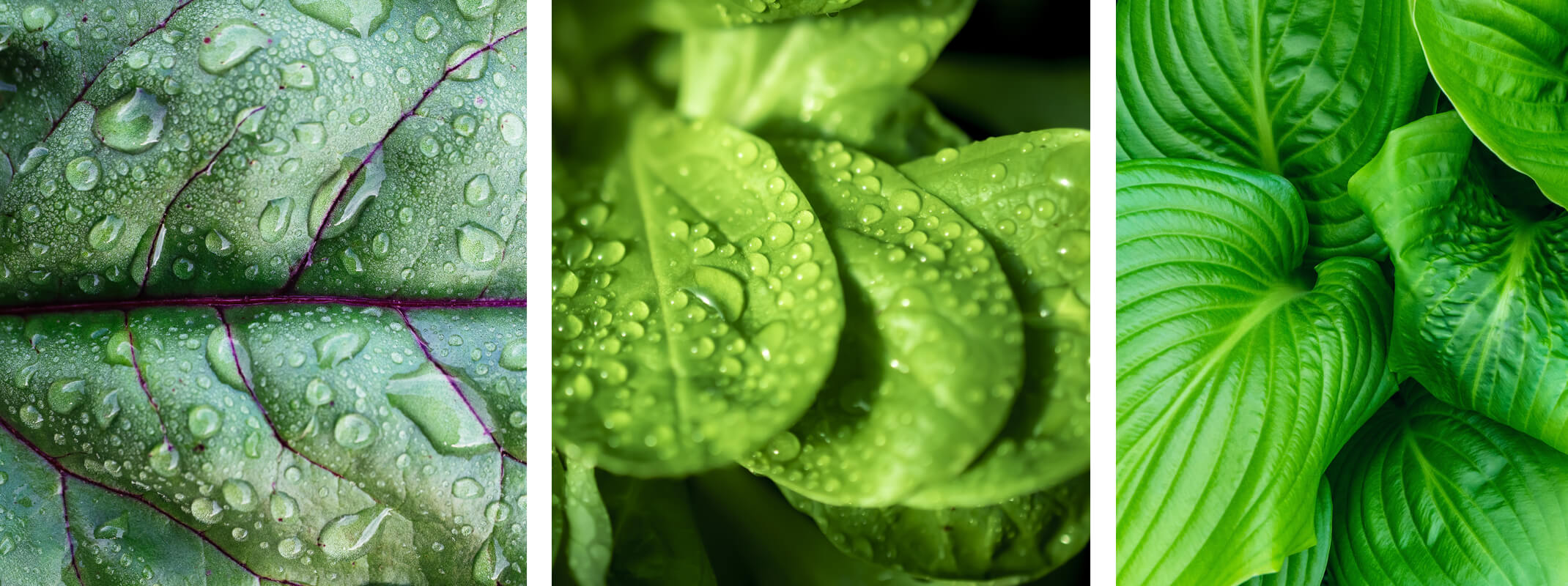
SummerWinds Nursery’s Most Wanted: Common Plant Pests and Diseases
Tackling plant pests and diseases is undoubtedly one of the less glamorous aspects of gardening, but if you’re quick to take action, you can save your plants from meeting an untimely end. Think of yourself as the defender of your plants, fighting crime one pest at a time! With the right tools in your kit and the knowledge to identify common culprits, you’ll be the hero your garden needs.
Watch Out For These Notorious Plant Pests
 Aphids
Aphids
What They Look Like
These tiny little pear-shaped bugs have long legs and antennae. They can be green, yellow, brown, red, or black, depending on what kind of plants they like to feed on. The most telltale sign of an aphid infestation is sticky droplets all over your plants. This substance is known as honeydew, which is a surprisingly pleasant name for what is essentially bug poop.
What’s The Damage?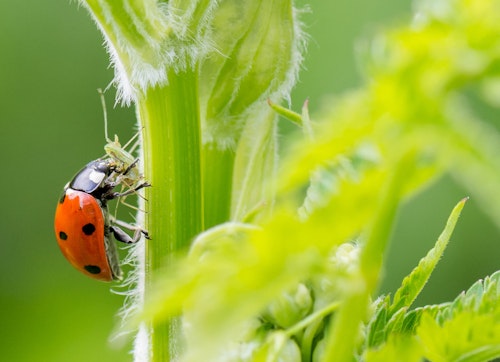
Aphids feed by sucking the moisture out of plants, which causes yellow leaves and stunts the growth of new shoots. While a small aphid outbreak isn’t likely to do large-scale damage, this is a plant pest with strength in numbers, so large colonies can do considerable damage. Their sticky honeydew rapidly builds up, which leads to all sorts of problems like mold growth or the arrival of ants who are attracted to the sugary substance. Some (but not all) aphids also inject a toxin into plants, which can distort growth and damage leaves even further.
How to Get Them Out
While it’s unlikely that aphids alone will end up taking down an entire plant, their damage is unsightly, and their waste can lead to a host of other problems. Use a non-chemical treatment to get rid of them—chemical pesticides can pose a major threat to beneficial bugs that help keep pest populations under control.
- Bug Boxes: Those beneficial bugs we just mentioned? You can buy them here at SummerWinds Nursery! Ladybugs are the most common commercially available predatory insect, and they come stored in a chilled container that coaxes them into hibernation. Once you bring them home and allow their temperature to rise, they’ll soon wake up with a raging appetite. Release them into your garden, and they will happily feed on aphids and other pesky insects.
- Ant Management: Since honeydew attracts ants, you may end up with double the pest problems. Furthermore, ants also protect aphids from their natural enemies, so when these bad bugs join forces, they can be harder to beat. Use Diatomaceous Earth
- Natural Pesticides: Several forms of chemical-free pesticides work wonders for killing the bad bugs while sparing our precious pollinators and predatory bugs. Bonide Insecticidal Soap spray, Bonide Horticultural Oil, and Bonide Neem Oil solution can all be safely used outside without posing a threat to beneficial wildlife.
Scales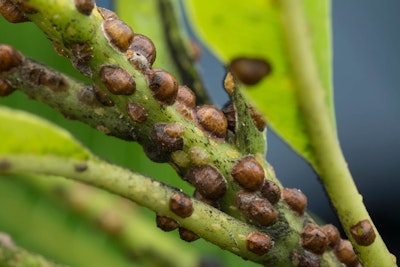
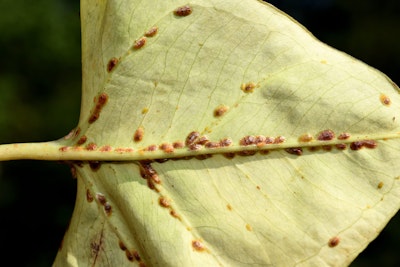
What They Look Like
These strange insects are masters of disguise. They definitely don’t look like your typical creepy-crawlies, but once you know what to look for, they’re much easier to spot.
- Armored Scales: Scale insects with armor look like tiny, hard bumps that don’t move. The actual insect body is hiding underneath the shell-like coating they produce, and if you pull their hard coating off, the bug will still remain on the plant. As the insect grows, the armor will grow with them, often with visible concentric circles, slight color variance, and a small tip that sticks out from the center. They’re under ⅛ inch in diameter and don’t produce honeydew.
- Soft Scales: These scales are a bit bigger, measuring around ¼ inch long, with a smooth surface that’s cottony or waxy in appearance. They’re a bit rounder than armored scales, and they produce lots of sticky honeydew.
What’s The Damage?
The severity of the damage is dependent on how bad the scale infestation is. You can expect to see some yellowing leaves, premature leaf drop, or possibly some blemishes on fruit, leaves, and twigs. Worst case scenario, you’ll see some twig dieback and will have to prune out all the dead bits. Honeydew droppings are the most significant problem you’ll encounter with scale insects because it attracts ants and can develop black mold. Soft scales aren’t likely to kill an entire tree or shrub, but they can weaken your plants and slow down growth, so it’s a good idea to get rid of them promptly.
How to Get Them Out
- Dormant Season: Late winter, when your plants and trees are dormant, is a great time to kill scale insects that may be overwintering on your deciduous woody plants. Spray a generous amount of Bonide Horticultural Oil all over the bark of terminal shoots.
- Foliage Spray: You can also use Bonide Horticultural Oil in spring or summer on deciduous plants when most scales are in their nymph stage. Spray any spots along the branches and shoots where you can see scale insects, and spray the undersides of the leaves, too—it’s one of the most common hiding spots for plant pests!
Thrips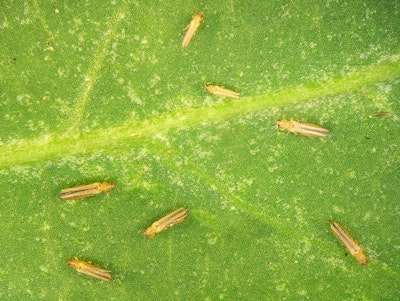
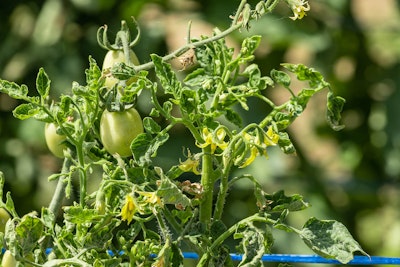
What They Look Like
Thrips are skinny insects with fringed wings and are usually a yellowish-brown color. They often leave behind a trail of tiny, black droppings that are shiny like varnish.
What’s The Damage?
It’s super easy to spot thrip damage if you know what to look for. They puncture plant leaves and suck out the contents, leading to discoloration, distorted leaves with a paper-like texture, tiny white spots (stippling), and premature leaf drop. While they aren’t likely to kill a tree or shrub, they can really injure vegetable plants and ornamentals if left untreated.
How to Get Them Out
A contact insecticide, like horticultural oil, or a Spinosad formula, like Captain Jack’s Deadbug Brew, will kick those thrips to the curb.
Whiteflies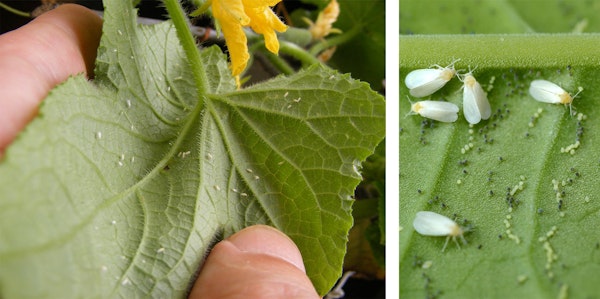
What They Look Like
These tiny little winged insects aren’t technically flies—they’re actually close relatives of the aphid. They got their name from the white, mealy wax that covers the adult’s wings and body.
What’s The Damage?
Whiteflies have needle-like mouthparts like a mosquito to pierce plant tissue and suck out the sap. If you’ve got a big swarm of whiteflies eating your plant, the leaves will turn yellow, curl up, dry out, and fall off. Whiteflies also excrete honeydew, so sticky residue and evidence of black mold are common red flags for these pests.
How to Get Them Out
It’s tricky to kill whiteflies because they’ll only kick the bucket if you directly spray them with natural insecticides. It certainly isn’t impossible, though—just perform a few repeat applications until their numbers dwindle. Bonide's Insecticidal Soap, Neem Oil, or Horticultural Oils will all work fine. Sticky traps are also a great solution.
Mealybugs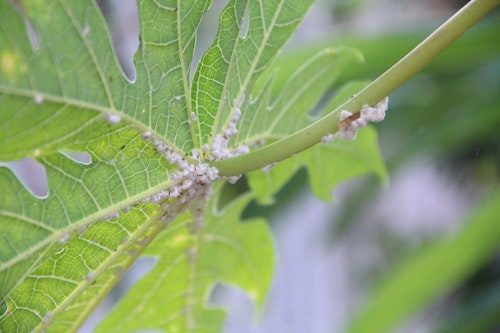
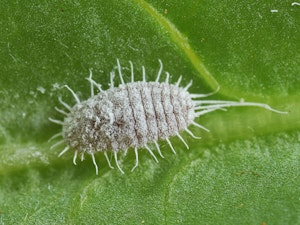
What They Look Like
If you’re creeped out by bugs, you won’t be pleased by the sight of a swarm of mealybugs. These little grey bugs have waxy, hair-like filaments that stick out all over their bodies. They don’t have wings, move slowly, and huddle together in groups, coating themselves in whitish mealy or cotton-like wax. Yuck!
What’s The Damage?
Like many common plant pests, mealybugs suck out the sap from plants and leave a trail of sticky honeydew behind them. They reduce the growth and vigor of plants and can negatively impact the quality of your fruits and veggies. Be on high alert for mealybugs in greenhouses and indoor plants because mealybugs are happiest in environments with consistently mild temperatures.
How to Get Them Out
- Isopropyl Alcohol Spot Treatments: A 70% alcohol solution is a super effective way to kill mealybugs, but you need to be careful when applying it as the treatment can dehydrate plant leaves. For indoor plants, it’s easy to dip a cotton swab in alcohol and apply it to the bugs directly. If you’ve got a major infestation, you can spray alcohol directly on the plant, but you should rinse it off with water an hour or two later to avoid dehydration. Repeat the application once per week until the mealybugs are gone.
- Natural insecticides: Insecticidal soaps, neem oil, and horticultural sprays work if applied directly onto the mealybugs. Repeat every 4–5 days until the problem is resolved.
Snails & Slugs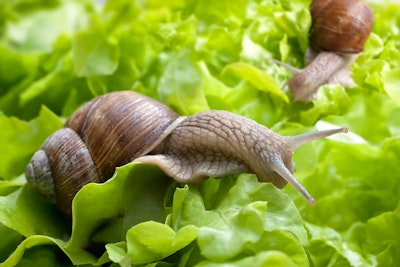
What They Look Like
You’re probably familiar with slugs and snails—the peculiar, slow-moving mollusks that emerge from the garden at night, leaving behind trails of slime. But what you might not know is that they’re one of the most destructive plant pests out there! They may look harmless and maybe even kind of cute, but snails and slugs have huge appetites and will chow down on your plants like it’s an all-you-can-eat salad bar.
What’s The Damage?
Big, gaping holes in leaves, flowers, and fruit are bound to appear in your garden if hungry slugs and snails start to feast.
How to Get Them Out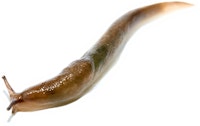
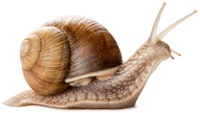
The best way to keep slugs and snails away is through a combined approach with prevention, trapping, barriers, pesticides, and simply hand-picking them off the plant. Here are a few methods and formulas that are worth trying out:
- Diatomaceous Earth: This abrasive substance is made from old fossils, and if you sprinkle it onto the soil, it will cut into the delicate bodies of slugs. This creates an effective barrier for keeping them away.
- Iron Phosphate Formulas: Products like Sluggo Slug and Snail Bait are pelletized formulas that slugs and snails will eat up, effectively killing them. It lasts for four weeks at a time and poses no threat to pets or other wildlife.
- Iron Phosphate Formulas: Products like Sluggo Slug and Snail Bait are pelletized formulas that slugs and snails will eat up, effectively killing them. It lasts for four weeks at a time and poses no threat to pets or other wildlife.
- Beer Traps: Hide little saucers of beer throughout the garden in shaded areas under leaf canopies. This will lure in the slugs and snails so you can easily toss them in the trash.
- Eliminate Pooling Moisture: If moisture is pooling in your garden, it can attract slugs and snails. Ensuring that your soil has good drainage and isn’t compacted will prevent this from happening.
Earwigs
What They Look Like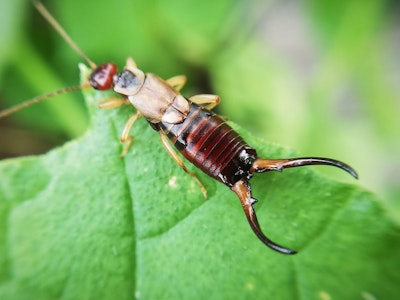
We won’t lie; spotting an earwig often results in shrieks of horror. The large pincers that stick out from their head are pretty startling. Don’t worry; they aren’t likely to bite unless you pick them up by hand and spook them. They don’t have any venom, so if you do get pinched, it can be easily cleaned and treated.
What’s The Damage?
If you’re seeing signs of plant damage and bite marks but can’t see any pests lingering around, earwigs might be to blame. They work at night, and during the day, they seek out dark, moist places to hide, such as dense weeds, low-growing vines, or underneath loose clods of soil or lawn debris. To confirm that earwigs are the culprits of your garden damage, go outside at night with a flashlight and scan the area.
How to Get Them Out
SluggoPlus is a formula that combines iron phosphate with Spinosad, and it’s great for killing earwigs and many other common plant pests.
Citrus Leafminer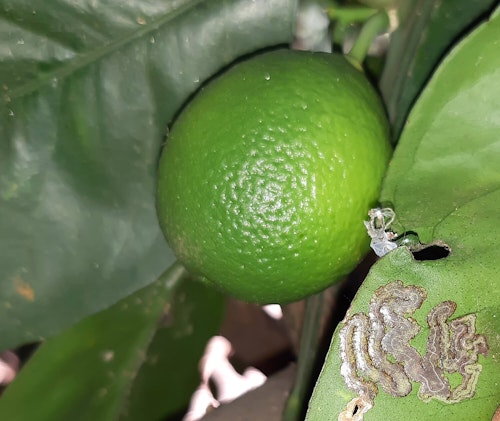
What They Look Like
The larvae of the citrus leafminer are the ones to watch out for. They can do major damage to the foliage of citrus trees, like lemon, lime, orange, grapefruit, and other closely related plants like kumquats and calamondin. You aren’t likely to see them directly because they crawl inside the leaves and munch their way through, creating squiggly white tunnels all over the leaves.
What’s The Damage?
Mature leaves aren’t likely to get overrun with leafminers unless you have a major infestation. New growth is much more vulnerable to leafminers, and the squiggly white lines are a telltale sign. This damage also leads to curling, distorted leaves.
How to Get Them Out
Use a Spinosad formula, such as Bonide's Captain Jack's Orchard Spray, Captain Jack’s Deadbug Brew, to combat leafminers. Trim off all damaged leaves with sanitized shears.
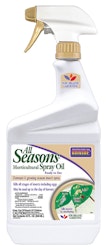
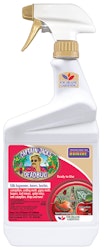
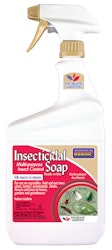
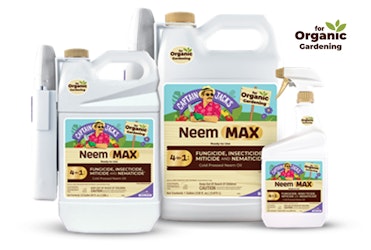

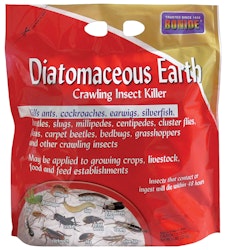
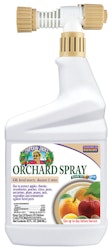

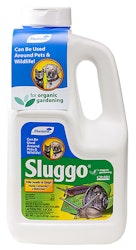
Guide to Common Plant Diseases
Plant diseases and fungi can be tricky to treat because they spread through microscopic spores that can travel on a breeze or lay dormant over winter, ready to strike once the temperatures rise. Treating them early is key to reducing the damage and spread. Remember to permanently dispose of diseased plant parts in the garbage, not the compost bin, and sanitize your shears with disinfectant before and after making cuts.
Phytophthora Root and Crown Rot
This disease affects pretty much all fruit and nut trees, plus many ornamental trees, shrubs, tomatoes, peppers, eggplants, and even some common California native plants. It occurs in warm soil that has been moist for too long or along the stems of plants that have been planted too deeply in damp soil.
How to Spot It
Symptoms of phytophthora root and crown rot include:
- Browning of the outer layer of sapwood
- Noticeably stressed out leaves
- Rapid wilting or death as the warmer spring weather sets in
- Leaves turning dull green, yellow, or sometimes even reddish purple
- A visible change in color and texture in one branch or stem that gradually spreads through the rest of the plant
How to Deal with It
Maintaining good soil drainage can help prevent a number of diseases, but it’s especially important for preventing root and crown rot. Try not to water your trees directly on their trunk or allow too much moisture to pool around the base. If you use sprinklers, make sure they are positioned at a low angle and won’t spray the base of your plant directly. If you’re using drip irrigation, place the emitters a foot or two away from the trunk. When planting your trees, shrubs, and vegetable starters, don’t bury their stems deeply or pile up dirt around the base.
Peach Leaf Curl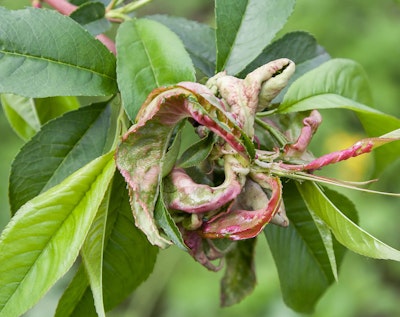
How to Spot It
Peach trees and other related fruit trees, like nectarines, are susceptible to this disease. It progresses in 4 stages:
- 1) It appears in spring and causes leaves to develop red patches.
- 2) The red patches thicken, curl up and warp the shape of the leaf.
- 3) They turn yellowish-brown and will either stay on the branch or fall off.
- 4) The tree will produce a new set of replacement leaves that may or may not become affected by the disease, depending on whether you treat it properly.
While the tree will end up producing replacement leaves, it still ends up draining energy from the plant that would otherwise be spent on producing tasty fruit.
How to Deal With It
Copper fungicides are the best treatment for peach leaf curl, but they’re best used in winter during the dormant season. You’ve got to space out the applications properly, at least 30 days apart when the trees are still leafless. To save you the trouble of doing complicated calendar math, mark down these dates for fungicide application. They’re timed out perfectly and easy to remember:
- December 1st
- New Year’s Day
- Valentine’s Day
Follow these tips to make sure it works properly:
- Use a copper fungicide 24 hours before you follow up with horticultural oil.
- Apply it in the morning on a dry day that isn’t too windy, with no expected rain for at least 24 hours.
- Never apply copper fungicide if the leaf buds have already opened up. Make sure you apply it while they’re still closed.
Sooty Mold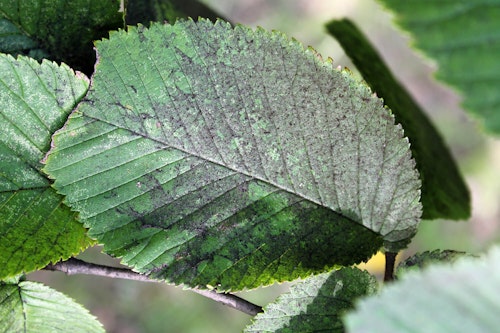
How to Spot It
This is the powdery, dark fungus resulting from honeydew left behind by bugs like aphids and whiteflies. While it doesn’t actually infect the plant, it blocks the sun from reaching the leaves, which messes with the plant’s ability to photosynthesize.
How to Deal With It
Use the appropriate insect control method to deal with whatever pests are leaving the honeydew droppings all over your plants. Cut out affected plant parts with disinfected shears, and dispose of the cuttings in the garbage. Spray with Bonide's Neem Oil.
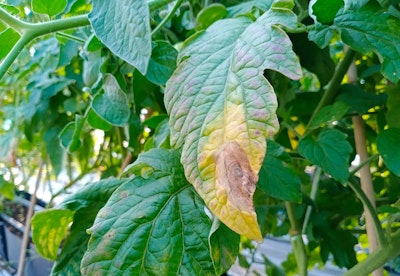 Early Blight
Early Blight
How to Spot It
You will start to see damage on the oldest foliage first. The affected leaves will have brown circular like lesions. Those leaves severely infected will turn yellow and drop off.
How to Deal With It
By maintaining optimum growing conditions: regular fertilization, watering, and management of pests, Early Blight can be minimized. Bonide Copper Fungicide is also effective.
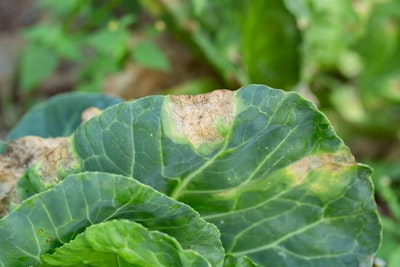 Downy Mildew
Downy Mildew
How to Spot It
Downy mildew will appear on leaves as small, light green to yellow spots and will remain in-between the veins of the leaf. The spots will eventually merge and turn brown. Older leaves will become infected first.
How to Deal With It
Look for varieties that are resistant to downy mildew. Avoid overhead irrigation. Watch for downy mildew during the vegetative growth stage through the production of fruit. Apply Monterey’s Garden Phos when symptoms first occur.
Blossom-End Rot
How to Spot It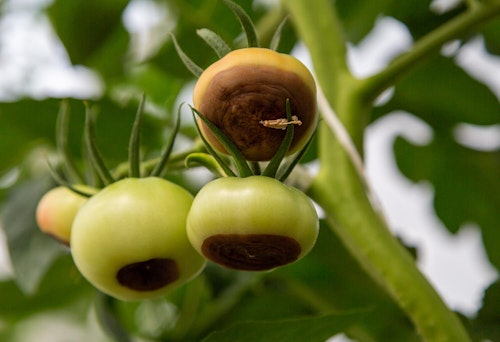
Blossom-end rot occurs due to a deficiency of calcium. You’ll see this more often when the tomato plants grow rapidly during the early part of the season and are subject to hot dry weather, when the fruits are in an early stage. Too much water, flushing through the soil may also cause the problem. Symptoms first appear as though the fruit it water soaked at bottom of the fruit. The spot will become brown and enlarge, and eventually turn leathery and sunken.
How to Deal With It
Once the problem exists, there is no curing it. However, the disorder can be avoided by using best practices. Be careful to avoid heavy applications of nitrogenous fertilizer and excess watering. Fertilizer for tomato plants should contain a balance of phosphorus and nitrogen. We recommend, E.B. Stone Organics Tomato and Vegetable Food. Another best practice includes using mulch around the base of the plants to reduce the loss of moisture from the soil. Bonide Tomato & Vegetable Spray or Maxi Cal, Bonide Rot-Stop® – created specifically for blossom-end rot will also help.
Fire Blight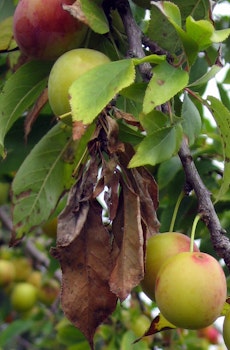
How to Spot It
Apple and pear trees are most commonly affected by this destructive disease, and the first signs can appear as soon as the trees begin their spring growth spurt. Fire blights first appear as oozing cankers on branches, twigs, and trunks. The ooze turns dark from air exposure, leaving streaks on the bark. These cankers are small and may be difficult to see in their early stages.
As the infection worsens, flowers, fruits, and stems will blacken and shrivel, looking like they got torched with fire. That’s why they call it fire blight! Open flowers are the most vulnerable to infection, but the disease can also spread through the branches, trunk, and root systems. Fire blight can eventually kill the tree if left untreated. To see if fire blight has spread through the wood of your tree, chip a bit of the bark away near an active canker. If the wood underneath has pink or orangey-red streaks, the blight is spreading.
How to Deal With It
Specific temperature and weather conditions create the ideal environment for fire blight to make an appearance. 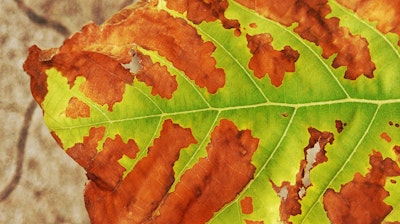 When the temperature is hovering around 75°–85°F, with heavily humid weather or rain, this can be a recipe for a fire blight outbreak. Be on high alert for signs of fire blight on your apple and pear trees when the weather is warm and damp. Apply copper fungicide in late winter to help build up your tree’s defense against fire blight. Avoid irrigating your tree while it’s actively blooming, avoid heavy pruning between March and December, and don’t use fertilizers with high levels of nitrogen. Pruning damaged pieces off before they spread can help your tree bounce back from fire blight, but it spreads rapidly and can kill the tree if you don’t deal with it quickly. And finally, you can apply Monterey's Garden Phos.
When the temperature is hovering around 75°–85°F, with heavily humid weather or rain, this can be a recipe for a fire blight outbreak. Be on high alert for signs of fire blight on your apple and pear trees when the weather is warm and damp. Apply copper fungicide in late winter to help build up your tree’s defense against fire blight. Avoid irrigating your tree while it’s actively blooming, avoid heavy pruning between March and December, and don’t use fertilizers with high levels of nitrogen. Pruning damaged pieces off before they spread can help your tree bounce back from fire blight, but it spreads rapidly and can kill the tree if you don’t deal with it quickly. And finally, you can apply Monterey's Garden Phos.
Powdery Mildew
How to Spot It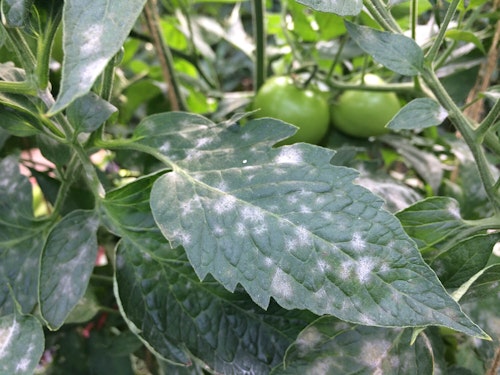
Powdery mildew is a fungus that coats your plants with a white powder, just like a jelly donut. It can affect old growth or new growth, usually on leaves and shoots, but sometimes on fruits and flowers. It’s a pretty common fungus and affects all sorts of different garden plants; however, many different strains only target specific types of plants. This means the type of powdery mildew that affects cucurbits, like melons and squashes, is a totally different kind than the powdery mildew that affects roses. In other words, you don’t have to worry about one strain wiping out your entire garden.
How to Deal With It
Powdery mildew will often appear if there isn’t enough air circulation between your plants’ leaves. If you water them overhead, or if there’s a heavy rain and water collects between the leaves and doesn’t evaporate, mildew may start to form. Prevent it by thinning dense foliage with pruning shears, adequately spacing out your plants, planting them in full sun (if appropriate), and watering them at the soil level instead of overhead.
Some ornamentals like roses and crape myrtles are super vulnerable to powdery mildew, so using a copper fungicide at the beginning of the season is a good idea. Remember to remove all the diseased plant parts with sanitized shears and dispose of them in the trash to stop the spread. Spray with Bonide's Neem Oil.
Botrytis Blight/Botrytis Cinereal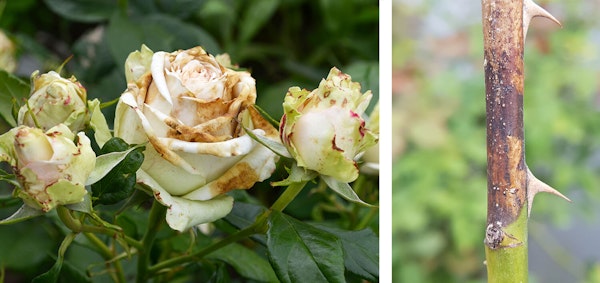
How to Spot It
This fungus pops up in humid weather and causes flowers to develop spots and discoloration. The flower buds, leaves, and shoots will rot, decay, and drop. Greyish-brown spore masses indicate an infection, but sometimes it may also cause bright magenta splotches. In bad cases, twigs may fall off, and buds won’t open.
How To Deal With It
Thin out the branches to promote air circulation, avoid watering overhead, and remove all diseased plant parts with sanitized shears. Dispose of any old branches or debris that might be hanging around the plant. Keep your plants consistently watered and fertilized to keep them strong so they’re better able to resist infection.
Black Spot/Diplocarpon Rosae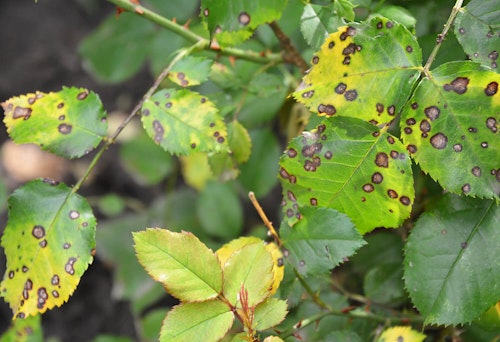
How to Spot It
Black spot affects roses, and it appears as—you guessed it—black spots. The areas around the black spots will turn yellow, and infected leaves may drop. It thrives in humid climates or dark, damp areas. Sometimes the black spots have feathery margins or tiny, fungal fruiting bodies sticking out.
How to Deal With It
Put these prevention tips into practice when growing roses to ensure they grow healthy and aren’t vulnerable to disease:
- Water early in the morning so the excess moisture evaporates from the sun before nightfall. Try to rinse off aphids if you see any.
- Provide adequate space between your rose bushes.
- Thin dense foliage to improve air circulation.
- Dispose of fallen leaves and branches that have collected around the roses.
- Plant roses in a spot with 6–8 hours of direct sun per day.
- Use copper fungicide.
- Prune off infected stems in winter.
- Try to choose disease-resistant rose varieties.
Rusts/Various Fungi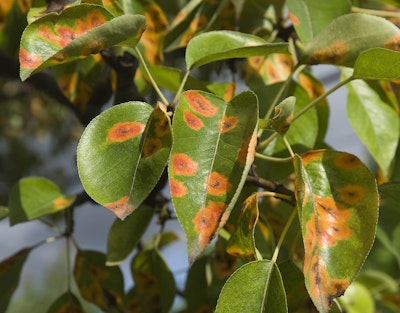
How to Spot It
Rust likes to make an appearance during cool, moist weather, so it’s a bit of an issue here on the coast. It can also develop in inland regions during particularly rainy periods. Leaves will get orangey-brown spots, and the leaves will eventually turn yellow or brown and will fall off early. While many rust problems can be treated easily with few side effects to your plants, severe rust can kill a plant. Environmental conditions and the nearness of other plants infected with rust will affect the severity of the case.
How to Deal With It
Prune off severely infected areas and apply a Bonide Copper Fungicide. Avoid overhead watering, and remember to collect and dispose of any leaves or branches that may have collected around your plants.
Sudden Oak Death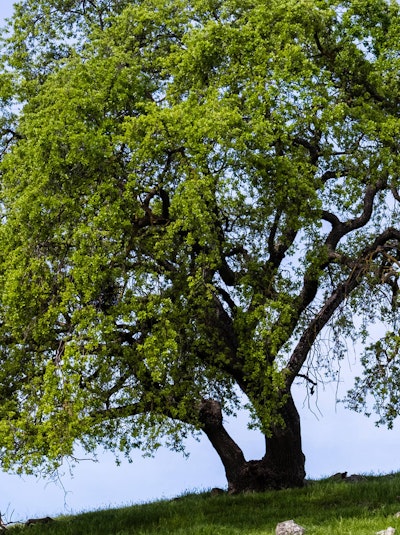
Over 1 million oak and tanoak trees have been killed in California over the past decade due to this invasive pathogen, Phytophthora ramorum. There are two categories of hosts for P. ramorum: trunk hosts and foliar hosts. Trunk hosts, like oaks and tanoaks, contract the infections through their bark. The infections are often fatal—plus, they also attract all sorts of other pathogens and pests that can further harm your trees. Foliar hosts, like bay laurel, contract the disease through their leaves and are usually the ones to blame when the pathogen is spreading.
How to Spot It
It’s kind of tricky to identify sudden oak death because the signs can look a lot like other ailments such as root and crown rot, boring insect infestations, wetwood bacteria, damage from improper irrigation, or even physical injury. However, if you suspect P. ramorum is the culprit, you can seek out a confirmed diagnosis.
Foliar hosts require foliar sampling, and you can do this by removing about ten affected leaves and submitting them for analysis. Contact your local Cooperative Extension or County Agricultural Commissioner’s office for more information on how sampling is performed in your area. Bark sampling for oaks and tanoaks is a trickier process. It’s a bit of a delicate process; it’s invasive and requires special equipment, so we recommend you enlist the help of a trained sampler.
How to Deal With It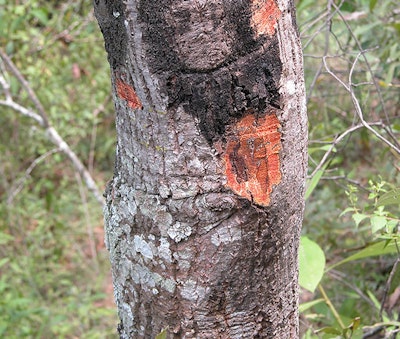
The bad news is that sudden oak death can’t be cured. However, it doesn’t always mean you have to cut down your trees. Foliar hosts, like bay laurel, are much more likely to spread the infection around, so it’s essential to remove these plants ASAP. Infected oaks may remain relatively healthy for several years and don’t need to be removed right away. That being said, the removal process for an infected tree is different than that of a regular tree, so you’ll definitely want to hire professionals to help.
To prevent the spread of P. ramorum, it’s a good idea to inspect any new plants you bring home. Many common garden plants can have P. ramorum spores lurking within them, and when they get shipped across the country, they can introduce the disease to new areas. Plant shipping is a strictly regulated practice, and SummerWinds Nursery is diligent about proper shipping practices and working with trusted buyers. Feel free to ask us for details about the measures we have in place to prevent sudden oak death.

